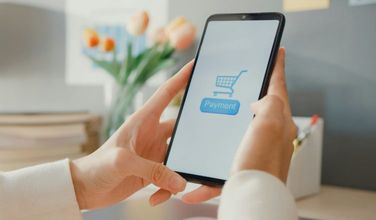- Osome Blog HK
- 2026 Ecommerce Trends
Top 11 Ecommerce Trends in Hong Kong for 2026
- Modified: 12 December 2025
- 12 min read
- Ecommerce


Heather Cameron
Author
Heather is here to inform and inspire our readers. Boasting eight years in the world of digital marketing, working in diverse industries like finance and travel, she has experience writing for various audiences. As Osome’s resident copywriter, Heather crafts compelling content, including expert guides, helpful accounting tips, and insights into the latest fintech trends that will help entrepreneurs, founders and small business owners in Hong Kong take their businesses to the next level.
Hong Kong’s ecommerce landscape has evolved rapidly in 2026, fuelled by mobile-first consumers, cross-border demand, and government-backed digital initiatives. Since mid-year, the sector has seen strong growth in mobile and social commerce, AI-powered personalisation, voice search functions, and ultra-fast delivery. With digital wallets now the norm and retailers expanding into Mainland China and beyond, Hong Kong is cementing its role as a strategic online commerce hub in Asia. This comprehensible guide will provide key insight into new ecommerce trends seen in Hong Kong's online shopping landscape.
Key Takeaways
- Mobile devices, social selling, personalised shopping experiences, and cross-border expansion are shaping Hong Kong's ecommerce market growth, with consumers demanding speed, convenience, and mobile-first experiences.
- Understanding consumer behaviour by age group and platform is essential for online retailers — different demographics favour different channels, from HKTVmall to Instagram and JD.com.
- Speed, personalisation, and payment flexibility are expected, making logistics and customer experience critical areas to get right from the start. Mobile shopping is projected to account for over 60% of all ecommerce sales by 2027, underscoring the importance of optimising for mobile-first users.
An Overview of Ecommerce in Hong Kong for 2026
An overview of Hong Kong's ecommerce landscape shows that online retail sales accounted for 8.4% of the country's total retail sales in August 2025, totalling HK$ 2.6 billion — an 8.9% year-on-year increase. July reflected an even stronger growth at 13.3%, while ecommerce sales for the first eight months of the year rose by 3.0% compared to 2024.
This ongoing growth in the ecommerce industry is propelled forward by Hong Kong’s position as a gateway between Mainland China and international markets, supported by an internet penetration rate of 95.6% and mobile access reaching 93.9%.
The total transaction value in Hong Kong’s digital payments market, the backbone of the ecommerce sector, is projected to reach HK$ 326.4 billion (US$ 41.85 billion) in 2025. This is expected to grow at a compound annual growth rate (CAGR) of 8.91% between 2025 and 2030, reaching HK$ 500.1 billion (US$ 64.12 billion) by the end of the period.
Entrepreneurs launching an ecommerce business in Hong Kong can benefit from working with ecommerce accountants as they navigate the practical roadmap of setting up, registering, and scaling their online ventures in a thriving digital market.
Key Ecommerce Platforms in Hong Kong
Ecommerce platforms in Hong Kong carry a diverse range of categories, with fashion, groceries, and beauty being the most dominant. Hong Kong’s ecommerce landscape in 2026 is shaped by a mix of local giants, international marketplaces, and social platforms. Different age groups favour different channels. Here’s a quick look at the most popular e-commerce platforms and who’s using them.
- HKTVmall: Popular among consumers aged 35+, especially for groceries, household goods, and essentials. It is known for fast delivery and a wide local selection.
- Taobao: Widely used across all age groups for fashion, lifestyle products, and cross-border ecommerce. It is favoured for variety and price competitiveness.
- Amazon: Used by those searching for consumer electronics, books, and international brands. It is known for cross-border fulfilment and global access.
- Zalora Hong Kong: Popular with younger shoppers (18–34) for trendy fashion, footwear, and accessories. It has a strong regional presence and curated collections.
- Shopee Hong Kong: Appeals to value-driven and younger consumers for affordable goods and flash sales. It is strong in mobile-first segments.
- Price.com.hk: A widely used price comparison and ecommerce site, ideal for electronics and tech-savvy shoppers.
- JD.com: A major Chinese online retailer with growing cross-border offerings in Hong Kong, popular for electronics, beauty, and daily essentials.
- Carousell: A classifieds-style marketplace for second-hand goods, used widely by younger and budget-conscious users.
- Ztore: A local online shopping site known for curated groceries, snacks, and Hong Kong-made products.
- Instagram Shops and TikTok (via Douyin in Mainland China): Fast-rising channels for Gen Z shoppers, driven by influencer content and impulse buying. These are key platforms for social commerce.
- Supermarket and Loyalty Apps (e.g. ParknShop, Wellcome, yuu): Widely used by older consumers and families for grocery delivery and reward points.
Instagram is one of the key online shopping channels for Gen Z shoppers and attracts an impressive number of buyers.
Hong Kong Ecommerce Consumer Demographics
Ecommerce behaviour in Hong Kong varies notably by age group, with each segment showing distinct preferences, motivations, and digital habits. Understanding these differences is key for brands aiming to tailor their offerings, platforms, and messaging.
Here's a look at the central characteristics of Hong Kong’s ecommerce consumers by age group.
Age Group | Key characteristics and behaviours |
|---|---|
| 18–24 | Mobile-first, trend-driven, highly influenced by social media and peers. Value sustainability and shop impulsively via apps. |
| 25–34 | Tech-savvy, price-sensitive, and convenience-oriented. Expect personalised experiences and use multiple shopping channels. |
| 35–44 | Online purchases are often family-focused and value-conscious. Shop for reliability and service, often mix online and offline purchases. |
| 45–54 | Brand-loyal and security-aware. Prefer trusted platforms, shop for family essentials, and value ease of use. |
| 55+ | Increasingly digital, cautious but engaged with online purchases. Favour simple, familiar platforms and shop mostly for health, groceries, and travel. |
11 Key Ecommerce Trends in Hong Kong
As Hong Kong’s ecommerce landscape continues to evolve rapidly, several emerging trends are shaping the market from 2025 into 2026. Understanding these trends is essential for ecommerce companies aiming to stay competitive and meet customer demands in this dynamic environment.
Here’s a breakdown of the top 11 ecommerce trends in Hong Kong:
1 Mobile commerce dominance
Retailers are optimising online stores for seamless mobile shopping experiences, including responsive design, fast loading times, and mobile-friendly checkout options like digital wallets (Apple Pay, Google Pay).
62% of online purchases in Hong Kong are made via mobile devices, underscoring the critical importance of mobile commerce in the region. With nearly 95% smartphone ownership among the population and 5G coverage exceeding 90%, mobile commerce is poised to continue its rapid expansion, solidifying its role as a primary sales channel in Hong Kong's dynamic ecommerce market.
2 AI-powered personalisation
Hong Kong's ecommerce market is rapidly embracing AI and machine learning technologies to deliver highly personalised shopping experiences. Local ecommerce companies are leveraging AI tools to analyse customer behaviour and customer data in real time, enabling dynamic pricing strategies and customised marketing campaigns that resonate with individual shoppers.
This adoption is supported by government initiatives promoting digital innovation and AI integration, helping Hong Kong maintain its position as a leading digital commerce hub in Asia. AI automation also improves operational efficiency by streamlining tasks across departments, further enhancing the capabilities of ecommerce companies.
3 Cross-border ecommerce growth
Hong Kong’s strategic position as a gateway to Mainland China and global markets fuels cross-border ecommerce. Businesses are expanding sales channels internationally, leveraging multi-currency support and localised marketing to tap into growing demand in global markets.
When shopping online for cross-border or imported products, 73% of consumers prefer Tmall International, followed by 63% who favour JD International. Other notable platforms include Douyin E-commerce Global, used by 30%, and Amazon China, chosen by 21% of shoppers according to HKTDC Research.
On the business side, 90% of Hong Kong companies expect cross-border ecommerce to drive revenue growth over the next two years. Major export markets include Mainland China (75.2%), ASEAN countries (53.0%), and the US (42.2%), with Mainland China and ASEAN seen as holding the most promising growth potential. This cross-border activity is a key driver of Hong Kong’s ecommerce future growth, enabling businesses to access dynamic markets and diversify their customer base.
4 Flexible payment options
Consumers increasingly expect multiple payment methods, including Buy Now, Pay Later (BNPL), digital wallets, and credit cards. A recent Worldpay report suggests that digital payment methods are set to dominate Hong Kong’s payment landscape by 2030, accounting for an estimated 45% of all online transaction value and 48% of in-store payments.
Hong Kong is following suit as Buy Now, Pay Later (BNPL) arrangements gain traction across the Asia-Pacific region, offering more flexible payment options and thus making online shopping more inclusive. Valued for their flexibility and interest-free structure, BNPL is becoming one of the primary payment methods among younger, budget-conscious consumers. According to Worldpay, the trend is expected to continue, with BNPL projected to grow 16% annually through 2027. In 2023 alone, BNPL accounted for 4% of online spending in APAC, with transaction values exceeding US$ 120 billion (approximately HK$ 936 billion).
Here is a look at how various payment options are faring in Hong Kong currently.
Payment Method | 2026 Share (of Online Payments) | Growth Trend | Key Notes |
|---|---|---|---|
| Digital Wallets (e.g. AlipayHK, PayMe, Apple Pay) | ~35–40% | ▲ Rapid growth | Expected to reach 45% of all online transactions by 2030 |
| Credit / Debit Cards | ~30% | ▬ Stable | Still preferred for high-ticket purchases |
| Buy Now, Pay Later (BNPL) | ~4% (2023 baseline) | ▲ +16% CAGR (to 2027) | Popular among younger, budget-conscious consumers |
| Bank Transfers | ~15% | ▼ Gradual decline | Used mainly for B2B or large transactions |
| Cash on Delivery / Others | <10% | ▼ Declining | Limited use, mostly for older demographics |
5 Sustainability and eco-friendly practices
Ecommerce brands adopting sustainable practices, ethical sourcing, and transparent practices are seeing effective brand differentiation as customer focus shifts from value-only to a combination of value and social impact. In Hong Kong, 70% of consumers consider a brand's sustainability record important when making purchasing decisions, highlighting the growing demand for eco-friendly practices in the ecommerce industry. Consumers increasingly prefer brands that align with their sustainability values, with 73% of Gen Z willing to pay more for sustainable products.
6 Augmented Reality (AR) integration
Augmented reality (AR) technology helps customers visualise products in their real-world environment before buying, reducing purchase hesitation and return rates by up to 30%. Hong Kong retailers are increasingly incorporating AR in categories like fashion, beauty, and furniture to enhance the online shopping experience. AR-shopping is also a leading player in business to business transactions since the perchase often involves heavy machinery, large displays, and other products that would otherwise require physical samples and site visits to ensure accuracies.
7 Ultra-fast delivery and logistics innovation
With a growing consumer demand for quick delivery, Hong Kong ecommerce companies are investing in advanced logistics solutions, including AI-driven inventory management, automated warehouses, and same-day delivery options. Approximately 70% of online shoppers in Hong Kong expect delivery within 2-3 days, making ultra-fast delivery a key driver of customer satisfaction and repeat business.
Company incorporation is the first step to starting any ecommerce business. Doing so in an organised manner will help set your business up on a strong foundation.
8 Social commerce and live shopping events
Social shopping is becoming one of the most significant industry trends shaping the ecommerce world in Hong Kong.
Social media platforms in Hong Kong are rapidly evolving into dynamic marketplaces, with livestreaming ecommerce emerging as a key sales channel for local brands to connect directly with consumers. Approximately 75% of consumers in Hong Kong shop via social media, making an average of 7 purchases each month.
Leading platforms such as Instagram, TikTok (including Douyin for Mainland China audiences), and Facebook have integrated shopping features that allow users to browse and purchase products seamlessly without leaving the app. Influencer partnerships are instrumental in driving engagement, with a growing number of Hong Kong consumers making purchases via social commerce.
Social shopping is projected to grow with a CAGR of 40.1% between 2023 and 2028, highlighting its increasing importance in the ecommerce ecosystem.
9 Omnichannel and online-to-offline (O2O) strategies
Businesses are blending their online and offline presences, creating unified shopping experiences and using online-to-offline strategies to drive traffic and sales. Omnichannel shoppers have a 30% higher lifetime value compared to single-channel shoppers.
By integrating online platforms with brick-and-mortar stores, retailers can offer services such as click-and-collect, in-store returns, and exclusive in-store promotions tied to digital campaigns. This approach improves inventory management and personalises marketing, contributing to increased customer loyalty.
Tracking expenses in a fast-paced ecommerce world can be difficult without the right guidance. Here are some tips that can help.
10 Direct-to-consumer (D2C) and quick commerce
More brands in Hong Kong are adopting the direct-to-consumer (D2C) model to gain better control over their customer experience and profitability, bypassing traditional retailers. The Hong Kong D2C market is experiencing steady growth, driven by tech-savvy consumers who value personalised shopping experiences and faster delivery options. Local ecommerce brands are leveraging D2C strategies to collect valuable customer data, tailor marketing campaigns, and build stronger customer loyalty.
In Hong Kong specifically, quick commerce is rapidly gaining traction due to the city’s dense urban environment and high smartphone penetration rate. Local platforms such as HKTVmall and Foodpanda have expanded their quick commerce offerings, providing delivery within 20 to 30 minutes in key districts.
11 AI-integrated shopping experience
With technological innovation in machine learning and artificial intelligence, AI chatbots supporting conversational commerce and a curated selection of products, are becoming more popular in the e-commerce world.
For example, Google Assistant studies a customer's past shopping behaviour and average order value to suggests relevant products within one's budget, which significantly shortens the customer journey, allowing someone to find their desired goods without endless search and comparisons. Voice search powered by machine learning also creates an easier, more inclusive ecommerce experience for consumers of all types.
How Osome Can Help
Setting up an ecommerce business in Hong Kong can be complex, with incorporation, accounting, and regulatory compliance all requiring close attention — especially for solo founders or small teams. That’s where Osome steps in, offering a fully digital platform that handles company formation, cash flow monitoring, bookkeeping, tax filings, and more, all tailored to the needs of ecommerce entrepreneurs.
Whether you're selling locally or expanding cross-border, Osome helps simplify operations so you can focus on growth. Get in touch to find out how they can support your ecommerce journey in Hong Kong.
Summary
Hong Kong’s ecommerce ecosystem in 2026 presents huge opportunities for entrepreneurs and solo founders without worrying about overheads related to physical stores. With emerging technologies, mobile commerce, social selling, and cross-border selling, online sales is becoming easier and more robust than ever. Customer preferences for personalisation, fast delivery, and flexible payments are reshaping how businesses launch and scale.
Whether you're starting a fashion brand, exporting wellness products to China, or building a quick-commerce venture, understanding consumer expectations, digital marketing, buyer behaviour, and digital-first operations is essential to your shop's continued growth. With the right strategy — and the right support tools — ecommerce in Hong Kong is a powerful launchpad for regional success.






